Spruce
A spruce is a tree of the genus Picea /paɪˈsiːə/,[1] a genus of about 35 species of coniferous evergreen trees in the family Pinaceae, found in the northern temperate and boreal (taiga) regions of the Earth. Picea is the sole genus in the subfamily Piceoideae. Spruces are large trees, from about 20–60 m (about 60–200 ft) tall when mature, and have whorled branches and conical form. They can be distinguished from other members of the pine family by their needles (leaves), which are four-sided and attached singly to small persistent peg-like structures (pulvini or sterigmata[2]) on the branches, and by their cones (without any protruding bracts), which hang downwards after they are pollinated.[3] The needles are shed when 4–10 years old, leaving the branches rough with the retained pegs. In other similar genera, the branches are fairly smooth.
| Spruce | |
|---|---|
 | |
| Norway spruce (Picea abies) | |
| Scientific classification | |
| Kingdom: | Plantae |
| Clade: | Tracheophytes |
| Division: | Pinophyta |
| Class: | Pinopsida |
| Order: | Pinales |
| Family: | Pinaceae |
| Subfamily: | Piceoideae Frankis |
| Genus: | Picea Mill. |
| Species | |
|
About 35; see text. | |
Spruce are used as food plants by the larvae of some Lepidoptera (moth and butterfly) species, such as the eastern spruce budworm. They are also used by the larvae of gall adelgids (Adelges species).
In the mountains of western Sweden, scientists have found a Norway spruce, nicknamed Old Tjikko, which by reproducing through layering, has reached an age of 9,550 years and is claimed to be the world's oldest known living tree.[4]
Etymology
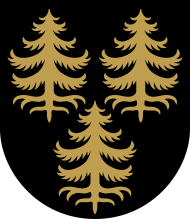
The Polish phrase z Prus ("from Prussia", a region now part of Poland) sounds to English ears like spruce. Spruce, spruse (1412), and Sprws (1378) seem to have been generic terms for commodities brought to England by Hanseatic merchants (especially beer, boards, wooden chests and leather), and the tree thus was believed to be particular to Prussia, which for a time was figurative in England as a land of luxuries. It can be argued that the word is actually derived from the Old French term Pruce, meaning literally Prussia.[5]
Classification
DNA analyses have shown that traditional classifications based on the morphology of needle and cone are artificial.[6][7] A recent study found that P. breweriana had a basal position, followed by P. sitchensis,[6] and the other species were further divided into three clades, suggesting that Picea originated in North America. Spruce has been found in the fossil record from the early Cretaceous, 136 million years ago.[8]
Species
Thirty-five named species of spruce exist in the world. The Plant List has 59 accepted spruce names.[9]
Basal species:
| Clade | Description | Image | Cone | Name | Common Name | Distribution |
|---|---|---|---|---|---|---|
| Clade I | Northern and western North America, in boreal forests or high mountains |  |
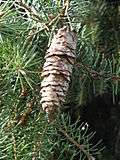 |
Picea breweriana | Brewer's spruce | Klamath Mountains, North America; local endemic |
 |
Picea sitchensis | Sitka spruce | Pacific coast of North America; the largest species, to 95 m tall; important in forestry | |||
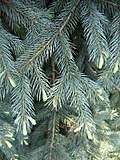 |
 |
Picea engelmannii | Engelmann spruce | western North American mountains; important in forestry | ||
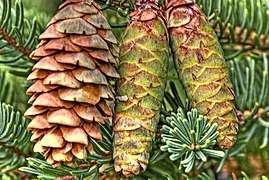 |
Picea glauca | white spruce | northern North America; important in forestry | |||
| Clade II | Throughout Asia, mostly in mountainous areas, a few isolated populations in higher elevations of Mexico |  |
Picea brachytyla | Sargent's spruce | southwest China | |
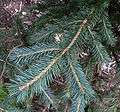 |
Picea chihuahuana | Chihuahua spruce | northwest Mexico (rare) | |||
| Picea farreri | Burmese spruce | northeast Burma, southwest China (mountains) | ||||
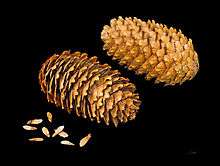 |
Picea likiangensis | Likiang spruce | southwest China | |||
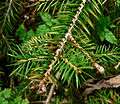 |
Picea martinezii | Martinez spruce | northeast Mexico (very rare, endangered) | |||
| Picea maximowiczii | Maximowicz spruce | Japan (rare, mountains) | ||||
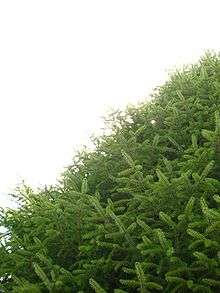 |
Picea morrisonicola | Taiwan spruce | Taiwan (high mountains) | |||
| Picea neoveitchii | Veitch's spruce | northwest China (rare, endangered) | ||||
 |
Picea orientalis | Caucasian spruce or Oriental spruce | Caucasus, northeast Turkey | |||
| Picea purpurea | purple cone spruce | western China | ||||
| Picea schrenkiana | Schrenk's spruce | mountains of central Asia | ||||
| Picea smithiana | morinda spruce | western Himalaya, eastern Afghanistan, northern and northwest India | ||||
| Picea spinulosa | Sikkim spruce | northeast India (Sikkim), eastern Himalaya | ||||
 |
Picea torano | tiger-tail spruce | Japan | |||
| Picea wilsonii | Wilson's spruce | western China | ||||
| Clade III | Europe, Asia, and North America, mostly in boreal forests or mountainous areas |  |
 |
Picea abies | Norway spruce | Europe; important in forestry, the original Christmas tree |
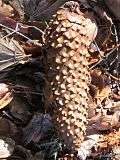 |
Picea alcoquiana – ("P. bicolor") | Alcock's spruce | central Japan (mountains) | |||
.jpg) |
Picea asperata | dragon spruce | western China; several varieties | |||
| Picea crassifolia | Qinghai spruce | China | ||||
| Picea glehnii | Glehn's spruce | northern Japan, Sakhalin | ||||
 |
Picea jezoensis | Jezo spruce | northeast Asia, Kamchatka south to Japan | |||
| Picea koraiensis | Korean spruce | Korea, northeast China | ||||
| Picea koyamae | Koyama's spruce | Japan (mountains) | ||||
.jpg) |
Picea mariana | black spruce | northern North America | |||
| Picea meyeri | Meyer's spruce | northern China (from Inner Mongolia to Gansu) | ||||
| Picea obovata | Siberian spruce | north Scandinavia, Siberia; often treated as a variant of P. abies (and hybridises with it), but has distinct cones) | ||||
 |
Picea omorika | Serbian spruce | Serbia and Bosnia; local endemic; important in horticulture | |||
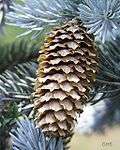 |
Picea pungens | blue spruce or Colorado spruce | Rocky Mountains, North America; important in horticulture | |||
| Picea retroflexa | green dragon spruce | China | ||||
 |
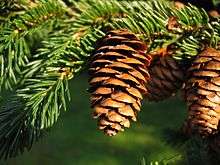 |
Picea rubens | red spruce | northeastern North America; important in forestry, known as Adirondack in musical-instrument making | ||
Morphology
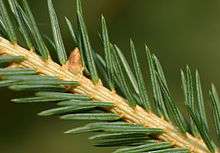
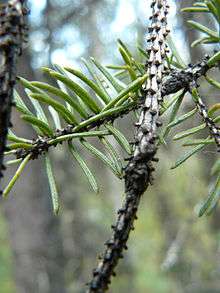
Determining that a tree is a spruce is not difficult; evergreen needles that are more or less quadrangled, and especially the pulvinus, give it away. Beyond that, determination can become more difficult. Intensive sampling in the Smithers/Hazelton/Houston area of British Columbia showed Douglas (1975),[10] according to Coates et al. (1994),[11] that cone scale morphology was the feature most useful in differentiating species of spruce; the length, width, length: width ratio, the length of free scale (the distance from the imprint of the seed wing to the tip of the scale), and the percentage free scale (length of free scale as a percentage of the total length of the scale) were most useful in this regard. Daubenmire (1974),[12] after range-wide sampling, had already recognized the importance of the 2 latter characters. Taylor (1959)[13] had noted that the most obvious morphological difference between typical Picea glauca and typical P. engelmannii was the cone scale, and Horton (1956,1959)[14][15] found that the most useful diagnostic features of the 2 spruces are in the cone; differences occur in the flower, shoot and needle, "but those in the cone are most easily assessed" (Horton 1959).[15] Coupé et al. (1982)[16] recommended that cone scale characters be based on samples taken from the midsection of each of 10 cones from each of 5 trees in the population of interest.
Without cones, morphological differentiation among spruce species and their hybrids is more difficult. Species classification for seeds collected from spruce stands in which introgressive hybridization between white and Sitka spruces (P. sitchensis) may have occurred is important for determining appropriate cultural regimens in the nursery. If, for instance, white spruce grown at container nurseries in southwestern British Columbia are not given an extended photoperiod, leader growth ceases early in the first growing season, and seedlings do not reach the minimum height specifications.[17][18] But, if an extended photoperiod is provided for Sitka spruce, seedlings become unacceptably tall by the end of the first growing season .[19] Species classification of seedlots collected in areas where hybridization of white and Sitka spruces has been reported has depended on (i) easily measured cone scale characters of seed trees, especially free scale length, (ii) visual judgements of morphological characters, e.g., growth rhythm, shoot and root weight, and needle serration, or (iii) some combination of (i) and (ii) (Yeh and Arnott 1986).[19] Useful to a degree, these classification procedures have important limitations; genetic composition of the seeds produced by a stand is determined by both the seed trees and the pollen parents, and species classification of hybrid seedlots and estimates of their level of introgression on the basis of seed-tree characteristics can be unreliable when hybrid seedlots vary in their introgressiveness in consequence of spatial and temporal variations in contributions from the pollen parent (Yeh and Arnott 1986).[19] Secondly, morphological characters are markedly influenced by ontogenetic and environmental influences, so that to discern spruce hybrid seedlot composition with accuracy, hybrid seedlots must differ substantially in morphology from both parent species. Yeh and Arnott (1986)[19] pointed out the difficulties of estimating accurately the degree of introgression between white and Sitka spruces; introgression may have occurred at low levels, and/or hybrid seed lots may vary in their degree of introgression in consequence of repeated backcrossing with parental species.
Growth
Spruce seedlings are most susceptible immediately following germination, and remain highly susceptible through to the following spring. More than half of spruce seedling mortality probably occurs during the first growing season and is also very high during the first winter,[20] when seedlings are subjected to freezing damage, frost heaving and erosion, as well as smothering by litter and snow-pressed vegetation. Seedlings that germinate late in the growing season are particularly vulnerable because they are tiny and have not had time to harden off fully.
Mortality rates generally decrease sharply thereafter, but losses often remain high for some years. "Establishment" is a subjective concept based on the idea that once a seedling has successfully reached a certain size, not much is likely to prevent its further development. Criteria vary, of course, but Noble and Ronco (1978),[21] for instance, considered that seedlings 4 to 5 years old, or 8 cm to 10 cm tall, warranted the designation "established", since only unusual factors such as snow mold, fire, trampling, or predation would then impair regeneration success. Eis (1967)[22] suggested that in dry habitats on either mineral soil or litter seedbeds a 3-year-old seedling may be considered established; in moist habitats, seedlings may need 4 or 5 years to become established on mineral soil, possibly longer on litter seedbeds.
Growth remains very slow for several to many years. Three years after shelterwood felling in subalpine Alberta, dominant regeneration averaged 5.5 cm in height in scarified blocks, and 7.3 cm in non-scarified blocks (Day 1970),[23] possibly reflecting diminished fertility with the removal of the A horizon.
Uses
Timber

Spruce is useful as a building wood, commonly referred to by several different names including North American timber, SPF (spruce, pine, fir) and whitewood (the collective name for spruce wood). Spruce wood is used for many purposes, ranging from general construction work and crates to highly specialised uses in wooden aircraft. The Wright brothers' first aircraft, the Flyer, was built of spruce.[24]
Because this species has no insect or decay resistance qualities after logging, it is generally recommended for construction purposes as indoor use only (indoor drywall framing, for example). Spruce wood, when left outside cannot be expected to last more than 12–18 months depending on the type of climate it is exposed to.[25]
Pulpwood
Spruce is one of the most important woods for paper uses, as it has long wood fibres which bind together to make strong paper. The fibres are thin walled and collapse to thin bands upon drying. Spruces are commonly used in mechanical pulping as they are easily bleached. Together with northern pines, northern spruces are commonly used to make NBSK. Spruces are cultivated over vast areas as pulpwood.
Food and medicine

The fresh shoots of many spruces are a natural source of vitamin C.[26] Captain Cook made alcoholic sugar-based spruce beer during his sea voyages in order to prevent scurvy in his crew.[27][28] The leaves and branches, or the essential oils, can be used to brew spruce beer.
The tips from the needles can be used to make spruce tip syrup . In survival situations spruce needles can be directly ingested or boiled into a tea.[29] This replaces large amounts of vitamin C. Also, water is stored in a spruce's needles, providing an alternative means of hydration . Spruce can be used as a preventive measure for scurvy in an environment where meat is the only prominent food source .
Tonewood
Spruce is the standard material used in soundboards for many musical instruments, including guitars, mandolins, cellos, violins, and the soundboard at the heart of a piano and the harp. Wood used for this purpose is referred to as tonewood.
Spruce, along with cedar, is often used for the soundboard/top of an acoustic guitar. The main types of spruce used for this purpose are Sitka, Engelmann, Adirondack and European spruces.
Other uses
The resin was used in the manufacture of pitch in the past (before the use of petrochemicals); the scientific name Picea derives from Latin picea "pitch pine" (referring to Scots pine),[30] from piceus, an adjective from pix "pitch".
Native Americans in North America use the thin, pliable roots of some species for weaving baskets and for sewing together pieces of birch bark for canoes. See also Kiidk'yaas for an unusual golden Sitka Spruce sacred to the Haida people.
Spruces are popular ornamental trees in horticulture, admired for their evergreen, symmetrical narrow-conic growth habit. For the same reason, some (particularly Picea abies and P. omorika) are also extensively used as Christmas trees, with artificial Christmas trees often being produced in their likenesses.
Spruce branches are also used at Aintree racecourse, Liverpool, to build several of the fences on the Grand National course. It is also used to make sculptures.
Diseases
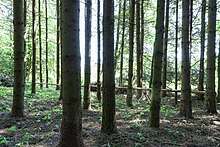
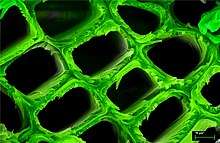
Sirococcus blight (Deuteromycotina, Coelomtcetes)
The closely related species Sirococcus conigenus and S. piceicola cause shoot blight and seedling mortality of conifers in North America, Europe, and North Africa.[31] Twig blight damage to seedlings of white and red spruces in a nursery near Asheville, North Carolina, was reported by Graves (1914).[32] Hosts include white, black, Engelmann, Norway, and red spruces, although they are not the plants most commonly damaged. Sirococcus blight of spruces in nurseries show up randomly in seedlings to which the fungus was transmitted in infested seed. First-year seedlings are often killed, and larger plants may become too deformed for planting. Outbreaks involving < 30% of spruce seedlings in seedbeds have been traced to seed lots in which only 0.1% to 3% of seeds were infested. Seed infestation has in turn been traced to the colonization of spruce cones by S. conigenus in forests of the western interior. Infection develops readily if conidia are deposited on succulent plant parts that remain wet for at least 24 hours at 10 °C to 25 °C. Longer periods of wetness favour increasingly severe disease. Twig tips killed during growth the previous year shows a characteristic crook.
Rhizosphaera kalkhoffi needle cast
Rhizosphaera infects white spruce, blue spruce (Picea pungens), and Norway spruces throughout Ontario, causing severe defoliation and sometimes killing small, stressed trees. White spruce is intermediately susceptible. Dead needles show rows of black fruiting bodies. Infection usually begins on lower branches. On white spruce, infected needles are usually retained on the tree into the following summer. The fungicide Chlorthalonil is registered for controlling this needle cast (Davis 1997).[33]
Valsa kunzei branch and stem canker
A branch and stem canker associated with the fungus Valsa kunzei Fr. var. picea was reported on white and Norway spruces in Ontario (Jorgensen and Cafley 1961)[34] and Quebec (Ouellette and Bard 1962).[35] In Ontario, only trees of low vigour were affected, but in Quebec vigorous trees were also infected.
Predators

Small mammals consume conifer seeds, and also eat seedlings. Cage feeding of deer mice (Peromyscus maniculatus) and red-backed vole (Myodes gapperi) showed a daily maximum seed consumption of 2000 white spruce seeds and of 1000 seeds of lodgepole pine, with the 2 species of mice consuming equal amounts of seed, but showing a preference for the pine over the spruce (Wagg 1963).[36] The short-tailed meadow vole (Microtus pennsylvanicus Ord) voraciously ate all available white spruce and lodgepole pine seedlings, pulling them out of the ground and holding them between their front feet until the whole seedling had been consumed. Wagg (1963)[36] attributed damage observed to the bark and cambium at ground level of small white spruce seedlings over several seasons to meadow voles.
Once shed, seeds contribute to the diet of small mammals, e.g., deer mice, red-backed voles, mountain voles (Microtus montanus), and chipmunks (Eutamias minimus). The magnitude of the loss is difficult to determine, and studies with and without seed protection have yielded conflicting results. In western Montana, for example, spruce seedling success was little better on protected than on unprotected seed spots (Schopmeyer and Helmers 1947),[37] but in British Columbia spruce regeneration depended on protection from rodents (Smith 1955).[38]
An important albeit indirect biotic constraint on spruce establishment is the depredation of seed by squirrels. As much as 90% of a cone crop has been harvested by red squirrels (Zasada et al. 1978).[39] Deer mice, voles, chipmunks, and shrews can consume large quantities of seed; 1 mouse can eat 2000 seeds per night.[40] Repeated applications of half a million seeds/ha failed to produce the 750 trees/ha sought by Northwest Pulp and Power, Ltd., near Hinton, Alberta (Radvanyi 1972),[41] but no doubt left a lot of well-fed small mammals. Foraging by squirrels for winter buds (Rowe 1952)[42] has not been reported in relation to young plantations, but Wagg (1963)[36] noted that at Hinton AB, red squirrels were observed cutting the lateral and terminal twigs and feeding on the vegetative and flower buds of white spruce.
Red squirrels in Alaska have harvested as much as 90% of a cone crop (Zasada et al. 1978);[39] their modus operandi is to cut off great numbers of cones with great expedition early in the fall, and then "spend the rest of the fall shelling out the seeds". In Manitoba, Rowe (1952)[42] ascribed widespread severing of branch tips 5 cm to 10 cm long on white spruce ranging "from sapling to veteran size" to squirrels foraging for winter buds, cone failure having excluded the more usual food source. The damage has not been reported in relation to small trees, outplants or otherwise.
Porcupines (Erethizon dorsatum L.) may damage spruce (Nienstaedt 1957),[43] but prefer red pine (McLeod 1956).[44] Bark-stripping of white spruce by black bear (Euarctos americanus perniger) is locally important in Alaska (Lutz 1951),[45] but the bark of white spruce is not attacked by field mice (Microtus pennsylvanicus Ord),[46] even in years of heavy infestation.
Pests
The eastern spruce budworm (Choristoneura fumiferana) is a major pest of spruce trees in forests throughout Canada and the eastern United States.[47] Two of the main host plants are black spruce and white spruce.[48] Population levels oscillate, sometimes reaching extreme outbreak levels that can cause extreme defoliation of and damage to spruce trees. To reduce destruction, there are multiple methods of control in place, including pesticides.[49]
Horntails, or Wood Wasps, use this tree for egg laying and the larvae will live in the outer inch of the tree under the bark.
Spruce Beetles (Dendroctonus rufipennis) have destroyed swathes of spruce forest in western North America from Alaska to Wyoming.
Genome
The nuclear,[50] mitochondrial[51][52] and chloroplast[53] genomes of British Columbia interior spruce have been sequenced. The large (20 Gbp) nuclear genome and associated gene annotations of interior spruce (genotype PG29) were published in 2013.[54] and 2015.[55]
References
- Sunset Western Garden Book, 1995:606–607
- Hart, G.T. (2018) Plants in Literature and Life: a wide-ranging dictionary of botanical terms. FriesenPress. ISBN 978-1770674417
- "Pine Relatives". Lovett Pinetum. Retrieved 27 August 2018.
- "Swedish Spruce Is World's Oldest Tree: Scientific American Podcast". 27 May 2008. Retrieved 21 August 2016.
- "spruce - Origin and meaning of spruce by Online Etymology Dictionary". www.etymonline.com. Retrieved 14 July 2020.
- Jin-Hua Ran; Xiao-Xin Wei; Xiao-Quan Wang (2006). "Molecular phylogeny and biogeography of Picea (Pinaceae): implications for phylogeographical studies using cytoplasmic haplotypes" (PDF). Molecular Phylogenetics and Evolution. 41 (2): 405–419. doi:10.1016/j.ympev.2006.05.039. PMID 16839785. Archived from the original (PDF) on 24 April 2012.
- Aðalsteinn Sigurgeirsson & Alfred E. Szmidt (1993). "Phylogenetic and biogeographic implications of chloroplast DNA variation in Picea". Nordic Journal of Botany. 13 (3): 233–246. doi:10.1111/j.1756-1051.1993.tb00043.x.
- Ashley A. Klymiuk & Ruth A. Stockey (2012). "A Lower Cretaceous (Valanginian) seed cone provides the earliest fossil record for Picea (Pinaceae)". American Journal of Botany. 99 (6): 1069–1082. doi:10.3732/ajb.1100568. PMID 22623610.
- "Search results – The Plant List". www.theplantlist.org.
- Douglas, G.W. (1975). Spruce (Picea) hybridization in west-central British Columbia. B.C. Min. For., Forest Science, Smithers BC, unpublished report, cited by Coates et al. 1994. (Cited by Coates et al. 1994, orig. not seen)
- Coates, K.D.; Haeussler, S.; Lindeburgh, S.; Pojar, R.; Stock, A.J. (1994). Ecology and silviculture of interior spruce in British Columbia. Canada/British Columbia Partnership Agreement For. Resour. Devel., Victoria BC, FRDA Rep. 220. 182 p.
- Daubenmire, R. (1974). "Taxonomic and ecologic relationships between Picea glauca and Picea engelmannii". Can. J. Bot. 52 (7): 1545–1560. doi:10.1139/b74-203.
- Taylor, T.M.C. (1959). "The taxonomic relationship between Picea glauca (Moench) Voss and P. engelmannii Parry". Madroño. 15 (4): 111–115. JSTOR 41422994. (Cited in Coates et al. 1994).
- Horton, K.W. (1956). A taxonomic and ecological study of Picea glauca and Picea engelmannii in North America. Diploma thesis, Oxford Univ., U.K. 103 p.
- Horton, K.W. (1959). Characteristics of subalpine spruce in Alberta. Can. Dep. Northern Affairs National Resour., For. Branch, For. Res. Div., Ottawa ON, Tech. Note 76. 20 p.
- Coupé, R.; Ray, C.A.; Comeau, A.; Ketcheson, M.V.; Annas, R.M. (1982). A guide to some common plants of the Skeena area, British Columbia. B.C. Min. For., Res. Branch, Victoria BC.
- Arnott, J.T. (1974). "Germination and seedling establishment". pp. 55–66 in Cayford, J.H. (Ed.). Direct Seeding Symposium, Timmins ON, Sept. 1973, Can. Dep. Environ., Can. For. Serv., Ottawa ON, Proc., Publ. 1339.
- Arnott, J.T. (1979). "Effect of light intensity during extended photoperiod on growth of amabalis fir, mountain hemlock, and white and Engelmann spruce seedlings". Can. J. For. Res. 9: 82–89. doi:10.1139/x79-014.
- Yeh, F.C.; Arnott, J.T. (1986). "Electrophoretic and morphological differentiation of Picea sitchensis, Picea glauca, and their hybrids". Can. J. For. Res. 16 (4): 791–798. doi:10.1139/x86-140.
- Alexander, R.R. (1987). Ecology, silviculture, and management of the Engelmann spruce–subalpine fir type in the central and southern Rocky Mountains. USDA, For. Serv., Washington DC, Agric. Handb. 659. 144 p.
- Noble, D.L.; Ronco, F. (1978). Seedfall and establishment of Engelmann spruce and subalpine fir in clearcut openings in Colorado. USDA, For. Serv., Rocky Mountain For. Range Exp. Sta., Res. Pap. RM-200. 12 p.
- Eis, S. (1967). "Establishment and early development of white spruce in the interior of British Columbia". For. Chron. 43 (2): 174–177. doi:10.5558/tfc43174-2.
- Day, M.W.; Rudolph, V.J. (1970). Development of a white spruce plantation. Michigan State Univ., Agric. Exp. Sta., East Lansing MI, Res. Pap. 111. 4 p.
- "Milestones of Flight - 1903 Wright Flyer". Smithsonian National Air and Space Museum. 28 April 2016. Archived from the original on 5 April 2004. Retrieved 21 August 2016.
- "Picea Genus (spruce)". American Conifer Society. American Conifer Society. Retrieved 13 June 2019.
- "Tree Book - Sitka spruce (Picea sitchensis)". British Columbia Ministry of Forests, Lands and Natural Resource Operations. Retrieved 29 July 2006.
- Crellin, J. K. (2004). A social history of medicines in the twentieth century: to be taken three times a day. New York: Pharmaceutical Products Press. p. 39. ISBN 978-0789018441.
- Stubbs, Brett J. (June 2003). "Captain Cook's beer: the antiscorbutic use of malt and beer in late 18th century sea voyages". Asia Pacific Journal of Clinical Nutrition. 12 (2): 129–137. PMID 12810402.
- "Page not found". www.coolhemp.com. Archived from the original on 6 October 2018. Retrieved 10 January 2019.
- pĭcĕa. Charlton T. Lewis and Charles Short. A Latin Dictionary on Perseus Project.
- Rossman, AY; Castlebury, LA; Farr, DF; Stanosz, GR (2008). "Sirococcus conigenus, Sirococcus piceicola sp. nov. and Sirococcus tsugae sp. nov. on conifers: anamorphic fungi in the Gnomoniaceae, Diaporthales". Forest Pathology. 38: 47–60. doi:10.1111/j.1439-0329.2007.00529.x.
- Graves, A.H. (1914). "Notes on diseases of trees in the southern Appalachians". Phytopath. 4: 63–72.
- Davis, C. (24 September 1997) "Tree talk". The Sault Star. Marie, Ontario. p. B2.
- Jorgensen, E. and Cafley, J.D. (1961). "Branch and stem cankers of white and Norway spruces in Ontario". For. Chron. 37 (4): 394–400. doi:10.5558/tfc37394-4.CS1 maint: multiple names: authors list (link)
- Ouellette, G.B.; Bard, G. (1962). "Observations on a canker and resinosis in white and Norway spruce". Can. Dep. For., For. Ent. Path. Branch, Ottawa ON, Bi-mo. Progr. Rep. 18 (2): 2.CS1 maint: multiple names: authors list (link)
- Wagg, J.W.B. (1963). "Notes on food habits of small mammals of the white spruce forest". For. Chron. 39 (4): 436–445. doi:10.5558/tfc39436-4.
- Schopmeyer, C.S.; Helmers, A.E. 1947. Seeding as a means of reforestation in the northern Rocky Mountain Region. USDA For. Serv., Washington DC, Circular 772. 30 p.
- Smith, J.H.G. 1955 [1956 acc to E3999 bib]. Some factors affecting reproduction of Engelmann spruce and alpine fir. British Columbia Dep. Lands For., For. Serv., Victoria BC, Tech. Publ. 43 p. [Coates et al. 1994, Nienstaedt and Teich 1972]
- Zasada, J.C.; Foote, M.J.; Deneke, F.J.; Parkerson, R.H. 1978. Case history of an excellent white spruce cone and seed crop in interior Alaska: cone and seed production, germination and seedling survival. USDA, For. Serv., Pacific NW For. Range Exp. Sta., Portland OR, Gen. Tech. Rep. PNW-65. 53 p.
- Radvanyi, A (1970). "Small mammals and regeneration of white spruce forests in western Alberta". Ecology. 51 (6): 1102–1105. doi:10.2307/1933641. JSTOR 1933641.
- Radvanyi, A. 1972. Small mammals and regeneration of white spruce in western Alberta. p. 21–23 in McMinn, R.G. (Ed.). White Spruce: Ecology of a Northern Resource. Can. Dep. Environ., Can. For. Serv., Edmonton AB, Inf. Rep. NOR-X-40.
- Rowe, J.S. 1952. Squirrel damage to white spruce. Can. Dep. Resour. Devel., For. Branch, For. Res. Div., Ottawa ON, Silv. Leafl. 61. 2 p.
- Nienstaedt, H. 1957. Silvical characteristics of white spruce (Picea glauca). USDA, For. Serv., Lake States For. Exp. Sta., St. Paul MN, Pap. 55. 24 p.
- McLeod, J.W. 1956. Plantations of the Acadia Forest Experiment Station. Can. Dep. Northern Affairs National Resour., For. Branch, For. Res. Div., Ottawa ON, Tech. Note 31. 25 p.
- Lutz, H.J. (1951). "Damage to trees by black bears in Alaska". J. For. 49: 522–523.
- Littlefield, E.W.; Schoomaker, W.J.; Cook, D.B. (1946). "Field mouse damage to coniferous plantations". J. For. 44: 745–749.CS1 maint: multiple names: authors list (link)
- Out of Print : Biosystematic Studies of Conifer-Feeding Choristoneura (Lepidoptera Tortricidae) in the Western United States : Edited by Jerry A. Powell - University of California Press. www.ucpress.edu. Retrieved 23 October 2017.
- Balch, R.E.; Webb, F.E.; Morris, R.F. (1954). Results of spraying against spruce budworm in New Brunswick. Can. Dep. Agric., For. Biol. Div., Ottawa ON, Bi-mo. Progr. Rep. 10(1).
- Allison, Jeremy D.; Carde, Ring T. (2016). Pheromone Communication in Moths: Evolution, Behavior, and Application. Univ of California Press. pp. 265–271. ISBN 9780520964433.
- "Picea glauca, whole genome shotgun sequencing project". 13 March 2015. Cite journal requires
|journal=(help) - "Picea glauca, whole genome shotgun sequencing project". 12 January 2016. Cite journal requires
|journal=(help) - Jackman SD, Warren RL, Gibb EA, Vandervalk BP, Mohamadi H, Chu J, Raymond A, Pleasance S, Coope R, Wildung MR, Ritland CE, Bousquet J, Jones SJM, Bohlmann J, Birol I. (2015). "Organellar Genomes of White Spruce (Picea glauca): Assembly and Annotation". Genome Biology and Evolution. 8 (1): 29–41. doi:10.1093/gbe/evv244. PMC 4758241. PMID 26645680.CS1 maint: multiple names: authors list (link)
- "Picea glauca chloroplast, complete genome". 3 December 2015. Cite journal requires
|journal=(help) - Birol I, Raymond A, Jackman SD, Pleasance S, Coope R, Taylor GA, Yuen MM, Keeling CI, Brand D, Vandervalk BP, Kirk H, Pandoh P, Moore RA, Zhao Y, Mungall AJ, Jaquish B, Yanchuk A, Ritland C, Boyle B, Bousquet J, Ritland K, Mackay J, Bohlmann J, Jones SJ (2013). "Assembling the 20 Gb white spruce (Picea glauca) genome from whole-genome shotgun sequencing data". Bioinformatics. 29 (12): 1492–1497. doi:10.1093/bioinformatics/btt178. PMC 3673215. PMID 23698863.CS1 maint: multiple names: authors list (link)
- Warren RL, Keeling CI, Yuen MMS, Raymond A, Taylor GA, Vandervalk BP, Mohamadi H, Paulino D, Chiu R, Jackman SD, Robertson G, Yang C, Boyle B, Hoffmann M, Weigel D, Nelson DR, Ritland C, Isabel N, Jaquish B, Yanchuk A, Bousquet J, Jones SJM, Mackay J, Birol I, Bohlmann J. (2015). "Improved white spruce (Picea glauca) genome assemblies and annotation of large gene families of conifer terpenoid and phenolic defense metabolism". The Plant Journal. 83 (2): 189–212. doi:10.1111/tpj.12886. PMID 26017574.CS1 maint: multiple names: authors list (link)
External links
| Wikimedia Commons has media related to Picea. |
| Wikisource has the text of the 1879 American Cyclopædia article Spruce. |
- theplantlist.org / Picea (Spruce)
- conifers.org / Gymnosperm Database - Picea
- efloras.org / Picea
- pinetum.org / Arboretum de Villardebelle: Cones of selected species of Picea: page 1, Arboretum de Villardebelle page 2